Photographs of the Middle East have attracted a great deal of scholarly attention during the past four decades or so, paralleling the surge in postcolonial studies. Researchers have scrutinized the political implications of Orientalist and colonial images in provocative ways but overlooked the nineteenth-century modernity in the region. Nevertheless, modernity was a huge and complicated undertaking that extended from sciences to arts, literature, education, governmental and institutional structures, architecture, and urban and infrastructure planning. The physical aspects of the project were well documented through photographs, triggered by the Ottoman imperial interest in photography and reaching a peak during the reign of Sultan Abdülhamid II (1876–1908).1
Clearly not as seductive as images of exotic places and people, and consequently not so appealing to foreign tastes, the photographs that documented Ottoman modernity covered many categories, including infrastructure projects (railroads, bridges, tunnels, ports, and urban transportation), government buildings, schools, and factories. Medical science, the topic of the present paper, played a key role in this repertoire.
The importance attached to the modernization of health care by the Ottoman state is manifested in the proliferation of medical schools and hospitals throughout the empire. Closely following advances in Europe, Ottoman doctors struggled to keep up with the latest in medical methods and technologies and pursued the common nineteenth-century practices, particularly in army hospitals and the better-equipped state hospitals. Photographs of the time show a wide range of hospitals throughout the empire. They emphasize modern buildings and equipment, professional staff, and well-cared-for patients. Some photographs were collected in albums dedicated to a single building, others dispersed in groups organized according to region.2 A number of these images also found their way into popular publications disseminating information on the new architecture of health care in larger cities such as Beirut and Damascus as well as in smaller towns such as El-Deir on the Euphrates and Sanaa in Yemen, often with formal references to local aesthetic traditions.3
Medical photography encompassed clinical photographs, those that illustrated particular techniques, specimen photographs, and public-relations photographs and portraiture. Clinical photographs for purely scientific use feature frequently in these collections, including X-rays of body parts. Discovered in Germany by Wilhelm Conrad Röntgen in 1895, X-ray pictures became immensely popular and were reproduced in general and scientific periodicals and an “X-ray mania” invaded Europe and the United States (Evens 1995, 912). This discovery, which radically changed medical practice, was quickly adopted by Ottoman doctors under the leadership of Esad Feyzi, a medical student who succeeded in reproducing the technology in 1896 (Özlen 2014, 85). Proudly acknowledging the application of “all kinds of industrial and scientific progress” observed in the “civilized world,” an article in the popular avant-garde illustrated periodical Servet-i Fünun that year cast light on the immediate broad appeal of the X-ray as a curiosity device. As evidence of the development of Ottoman scientific skills, the journal presented two examples by Ottoman photographers, revealing the contents of a wallet and the broken lead in a pencil.4
The first large-scale medical use of the new technology in the Ottoman Empire took place a year later, in the Hamidiye Medical Hospital in Yıldız, Istanbul, where X-rays were taken of soldiers wounded during the Greco-Turkish War (Özlen 2014, 86). Like other photographs, these X-rays were mounted in decorated paper frames; their legends sometimes record information about the patient, although the latter was represented only skeletally. Such was the case of a soldier who could only be observed through the bones of his foot: his name was Osman bin Ibrahim and he belonged to the Third Army’s Fourth Battalion (see Fig. 1).
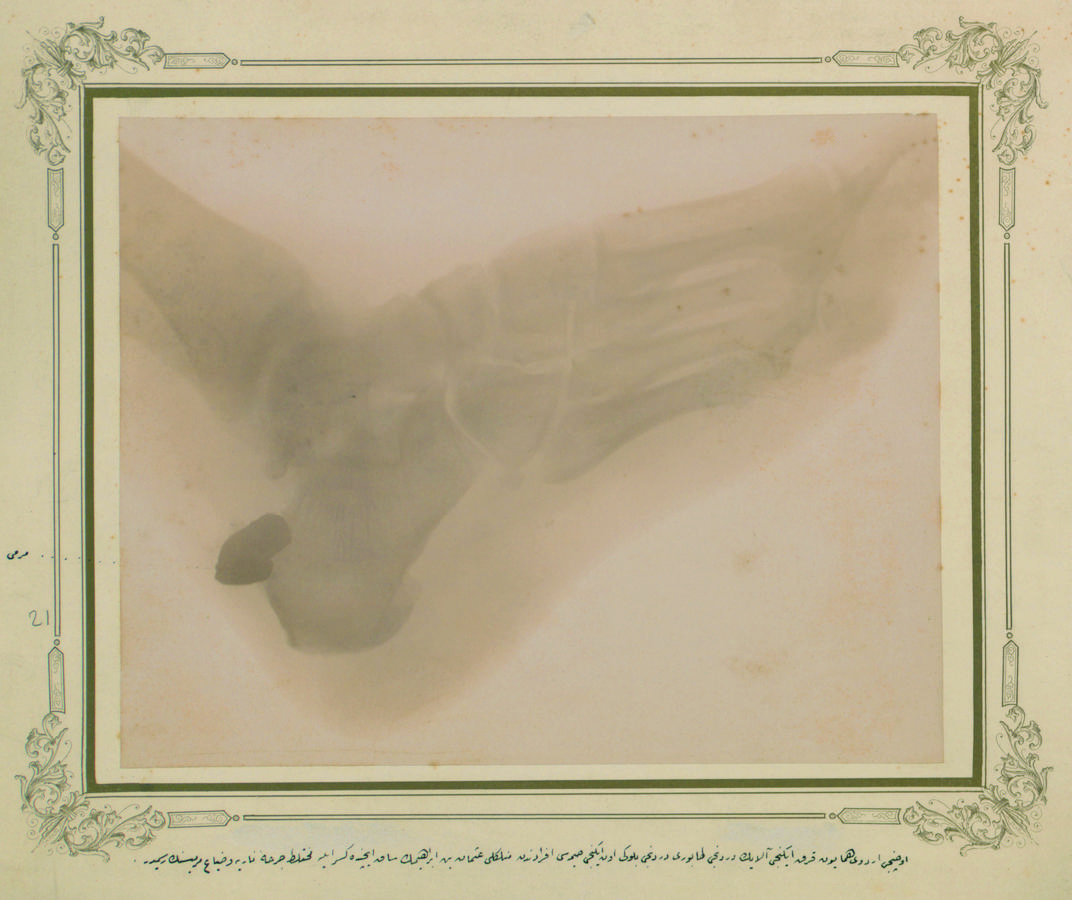
Fig. 1: X-ray of Osman bin Ibrahim’s foot (İÜMK 779-41-0021).
Another series was of before and after photographs depicting treatment of the ailments of soldiers and civilians, with captions explaining the problem and its remedy. “Hüseyin from Arapkir” was brought back to life by “extraordinarily rare and important surgery” to remove an enlarged spleen; the gentleman is shown holding the offending organ and pointing to his exposed surgical scar. Surgeries on large hernias and tumors were also recorded, the size of the growth indicating the seriousness of the illness. In some cases, the treatment process was presented in the inscription: The surgeon Cemil Pasha’s intervention to repair the broken left arm and wrist of “Mademoiselle Eleni from Fener” to complete recovery is seen in a set of three photographs.5
8.1 A modern hospital for women
Istanbul’s Haseki Women’s Hospital, which qualified as an “institution of charity that occupies the first place of honor” (müessesat-ı hayriye meyanında şimdiki halde birincilik şerefini ihraz etmiş olan) in 1892, had a long and illustrious history.6 The original building had been built in 1551 for Sultan Süleyman I’s wife Hürrem Sultan on the crowded site of Avratpazarı in the middle of the central peninsula of the city. The hospital’s chronogram described it as “a hospital beneficial to the people of the world” and its waqfiya (endowment deed) was worded with compassion. For example, the physicians had to be well educated in sciences and experienced. The list of required qualifications was long: they had to be passionate (selim kalpli), ethical (kerim ahlaklı), good-tempered (iyi huylu), diligent (iyi iş yapar), and sweet-tongued (hoş sözlü), for instance (Taşkıran 1972, 133). They also had to treat patients as affectionate friends, and avoid “unkind words that can be a heavier burden than the worst kind of affliction in invalids,” with the stipulations forming a striking contrast to Süleyman’s waqfiya, where what mattered was “competence in the science of medicine.”7
This major health institution of Istanbul underwent significant transformations throughout the centuries. In the nineteenth century, the facilities were not deemed adequate and with the rationale that Istanbul needed a proper women’s hospital, a modern compound was built between 1890 and 1893 to accommodate two hundred patients, on a site in the proximity of the original complex (Taşkıran 1972, 150–219). An album from the Abdülhamid II collection, composed of photographs of the new buildings taken by Abdullah Frères, enables us to reconstruct the new buildings (now destroyed, although the sixteenth-century complex is still standing). A plate by the project architect Patrocle Kampanaki locates the individual structures on a site plan and provides several façade and section drawings (see Fig. 2).
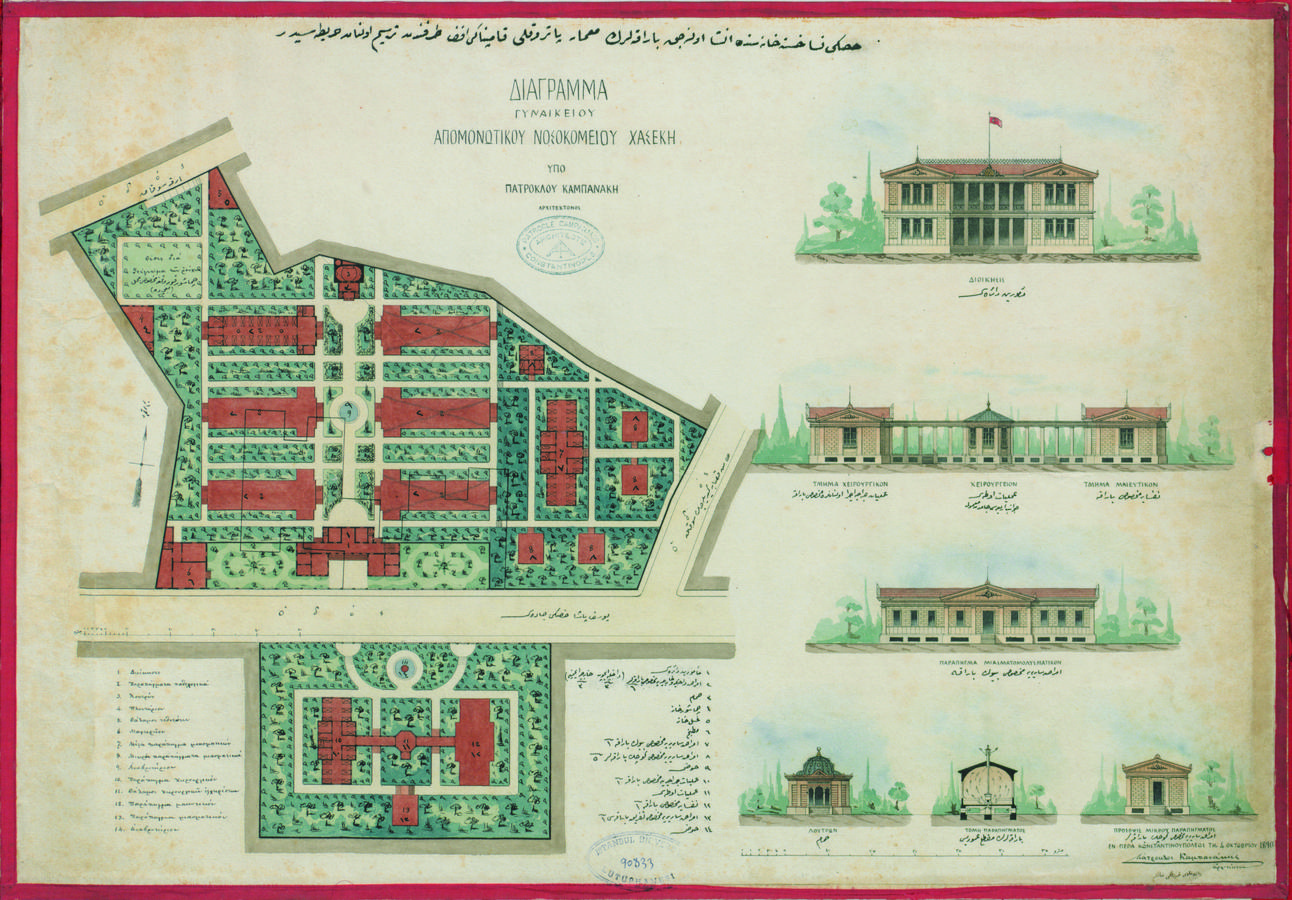
Fig. 2: Patrocle Kampanaki, site plan of the Haseki Sultan Hospital. The key indicates the following: 1. Administrative building, 2. Six pavilions for internal and external diseases, 3. Bathhouse, 4. Laundry, 5. Ablution room, 6. Kitchen, 7. Pavilion for contagious diseases, 8. Smaller pavilions for contagious diseases, 9. Pond, 10. Surgery recovery room, 11. Surgery, 12. Labor recovery room, 13. Pavilion for contagious diseases. Façade drawings on the right depict, from top to bottom, administrative building (no. 1), surgery (no. 11), connected to recovery room and labor recovery rooms (nos. 10 and 12), pavilion for contagious diseases (no. 7). At the bottom, we can see the bathhouse (no. 3), the heating system for pavilions (section drawings), and a small pavilion for contagious diseases (no. 8).
The buildings were sprawled across both sides of a major artery, Yusuf Paşa Haseki Caddesi, and followed the trend of the day in pavilion-type hospital design. To the north of the Yusuf Paşa Haseki Caddesi, on the site of a demolished mansion, the administrative building dominated the street façade, with all other buildings grouped within the gardens (see Fig. 3).8 On the first floor was a pharmacy, a waiting room, two examination rooms, and storage space. The second floor was occupied by doctors’ offices and a corridor, forty meters long, lined with cabinets and bookshelves (Taşkıran 1972, 138). The drawing displays an ornate design for all the building façades, but the photograph shows a much plainer one. This was presumably due to limited funding.
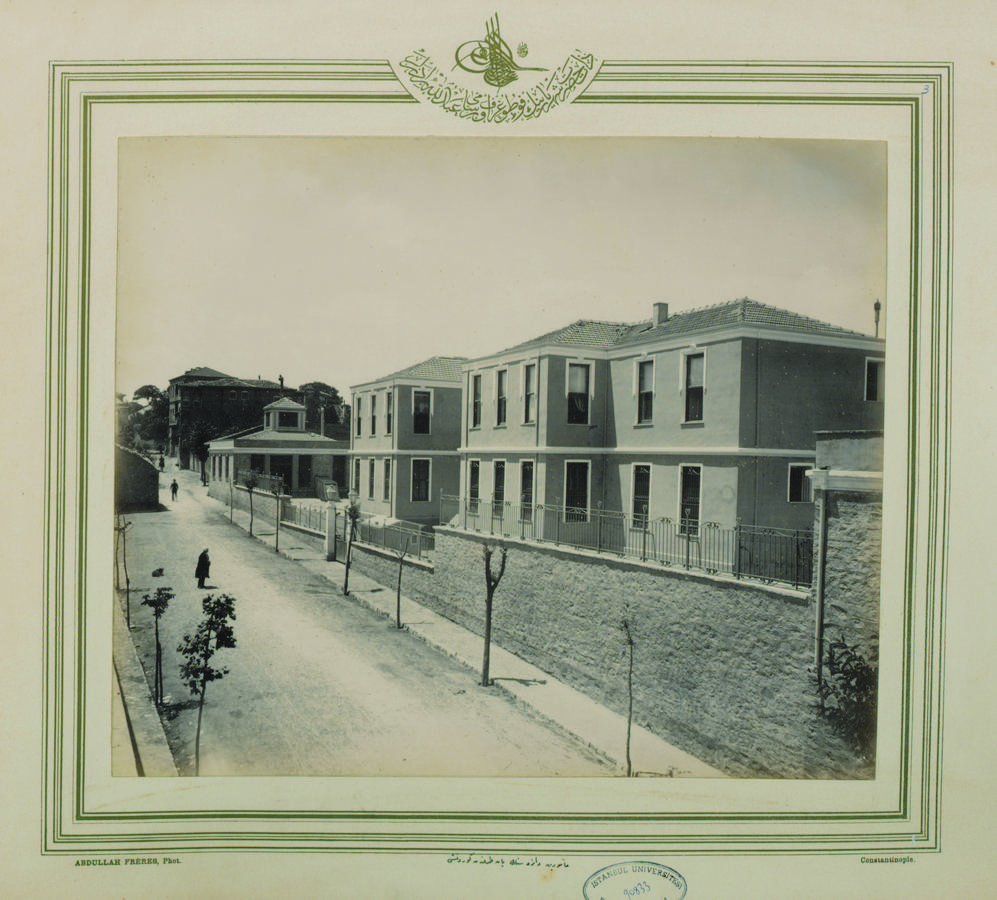
Fig. 3: Haseki Sultan Hospital, administration building (İÜMK 90833-0003).
Behind the administration building were six pavilions (baraklar), symmetrically arranged: three for internal and three for external diseases. The larger wards were organized in a uniform fashion, with two rows of beds. Beds and cabinets were imported from France and conformed to the standards established by the French Assistance Publique; they had painted aluminum frames—“very elegant” (gayet zarif)—and were objects of pride (Taşkıran 1972, 312). The pavilions were separated by an axial garden between the administrative building and the bathhouse, with a pond in the center. To the east was the section for contagious diseases (emraz-ı sariye), with a large pavilion surrounded by smaller pavilions. The laundry, the ablution room, and the kitchen were tucked away in the corners of the site.
To the south of the Yusuf Paşa Haseki Caddesi, an octagonal surgery room served as the central showpiece of the complex. It had interior walls of crystal glass and was furnished with surgical equipment imported from Paris (Taşkıran 1972, 313). Hallways connected two symmetrical wards to the surgery room; the west ward was for postsurgical recovery, while that on the east was for women who had given birth. Centrally placed stoves provided efficient heating. In brief, this was a truly modern hospital in all respects. An article in Servet-i Fünun applauded its “orderly and perfect” (muntazam ve mükemmel) spatial organization, “as wonderful as that of European hospitals”; its surgery facilities and all pavilions displayed “elegance” (nezafet) and “perfection” (mükemmelliyet). The author writing for Servet-i Fünun added that two French doctors who had visited the hospital endorsed these claims; they even expressed admiring awe at the refined sanitary equipment, such as bandages (sargı bezleri), which could only be found in a few establishments in Paris at the time.9
Haseki Nisa Hastahanesi is the subject of another rare album, from the collection of Ömer M. Koç, documenting the scope and success of surgery carried out in the hospital by focusing on the tumors removed from women’s wombs. The album crosses two genres of nineteenth-century photography: clinical records and portraits. It was the result of collaboration between the surgeon Ahmed Nureddin and the photographer Nicolas Andriomenos, both prominent figures in their fields.
Opérateur A Noureddin (as he signed his name on photographs) was a well-respected Istanbul surgeon specializing in womb diseases and complications of pregnancy and childbirth. He had “worked for the improvement of the Ottoman medical world,” according to an homage paid to him while he served as the director of the gynecology department of Haseki Women’s Hospital.10 Nureddin Bey remained affiliated with the hospital from 1890 to 1924, holding the position of Chief Doctor (başhekim) from 1909 onward (Taşkıran 1972, 318, 377, 379, 382). This album dates from his early years in the hospital, most likely the mid-1890s. Photographer Andriomenos, for his part, had run one of the most prominent photographic portrait studios in the Beyazit quarter of Istanbul since the late 1870s, not far from the Haseki Hospital (Öztuncay 2003). It is not surprising that the two teamed up.
8.2 Posing with tumors
The first photograph in the album is an aesthetically arranged composition and at the same time a systematic classification (see Fig. 4). It presents jars of tumors removed from sick women on a table, lined up according to size. The caption identifies the contents of each jar: most are fibroid tumors (verem-i lif) of the uterus, the exceptions being a tumor resulting from cancer of the cervix in the first jar on the right and two bladder stones, weighing 40 and 17 dirhems (129 and 54.4 grams), respectively, in the first jar on the left. The following twelve photographs focus on women, shot individually or in pairs, standing next to their preserved tumors. Captions identify their maladies, which include single and multiple ovarian cysts, cancerous ovarian cysts, and fibroid tumors. One photograph reported a Caesarian section to remove a fetus dead in the womb; no jar is present in that image. The captions explained the medical conditions and the organs from which the tumors were removed.
The women, standing erect and calm, advertise their own successful recovery. Several have been made to pose with a hand on the specimen jar, as though owning their particular tumors and taking pride in having overcome their illnesses. Their simple striped gowns and enveloping white head scarves, embroidered at the edges, lend these modest women an air of elegance and a sense of dignity, despite the uncomfortable exposure of their scars. The longitudinal area of bare flesh on each abdomen complements the small triangle of the face, each expressing a controlled demeanor. With their eyes directly confronting the camera, these women seem to acknowledge their personal contribution to science while claiming victory over their illness.
The photographs are part of a set of studio shots of individuals or small groups. Following a convention for images like this, they are staged in front of elaborate backdrops—although in this case the paraphernalia refers to the hospital’s offices—with ornate European-style furniture and patterned floors, reflecting the upper-class Ottoman taste of the era. In the photographic repertory of Ottoman women, they form a striking contrast to exoticized representations. The patients’ portraits also differ from the studio photographs of upper-class ladies in the simplicity of their uniform clothing and in their deployment as medical objects. The photographs enrich the more conventional documentations of female patients, for example, in the interior views of the clean and orderly wards in the same Haseki Hospital, where they pose seated in their beds, wrapped in modest white cover-ups and sheets.
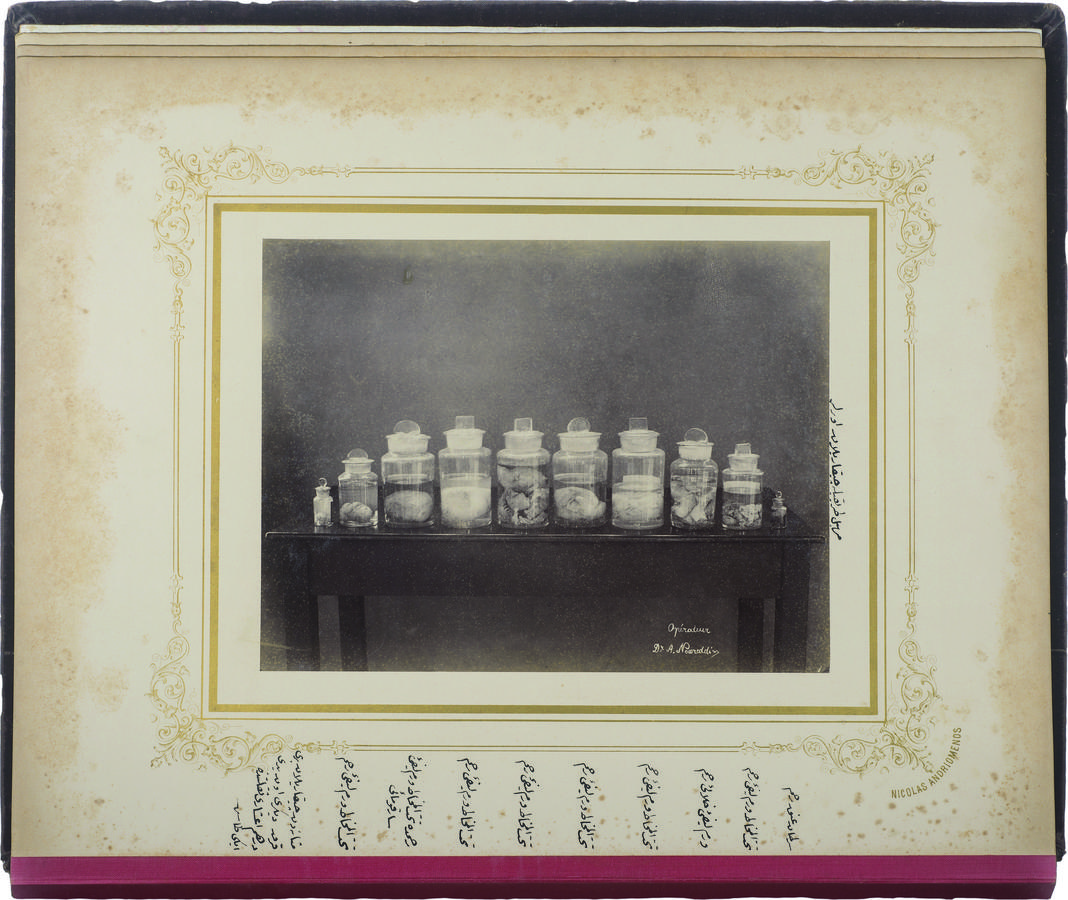
Fig. 4: Tumors extracted from wombs (Ömer M. Koç Album).
8.3 Medical objectification and female individuality
The formal consistency of these photographs, appropriate for a scientific record, is reminiscent of one of the best-known Ottoman photography projects, Elbise-i Osmaniye (Costumes populaires), prepared under the direction of Osman Hamdi Bey for the 1873 Universal Exposition in Vienna (Osman and de Launay 1873). Arguing for the “unity in diversity” of the Ottoman population, this protoethnographic collection documented the ethnic groups in the empire through their costumes. The differences between the two collections stem from their particular missions: in Elbise-i Osmaniye the figures in rich and varied costumes stand against a bare and uniform wall, the neutrality of the background highlighting the heterogeneity of the clothing; in the medical album, the patients wear uniform clothes but have been photographed in elaborately decorated spaces, lending them an oddly domestic aspect.
It is perhaps the uniformity of their attire that draws attention to the faces of the female patients and emphasizes their individuality, giving them an unexpected agency—a trait lacking in Elbise-i Osmaniyye. This is clearly conveyed in another version of the album in the Abdülhamid II collection, which contains only seven photographs of the women who had been treated (duplicates of the Ömer M. Koç album), instead of twelve.11 The longer captions in the Abdülhamid II album provide some personal information about the patients, further disrupting the putative neutrality of their presentation as medical objects. The texts include names, ages, and the Istanbul neighborhoods where they came from, together with more detailed information about their medical conditions. Their areas of residence, dispersed throughout the city, testify to the broad scope of the service Haseki Hospital provided.
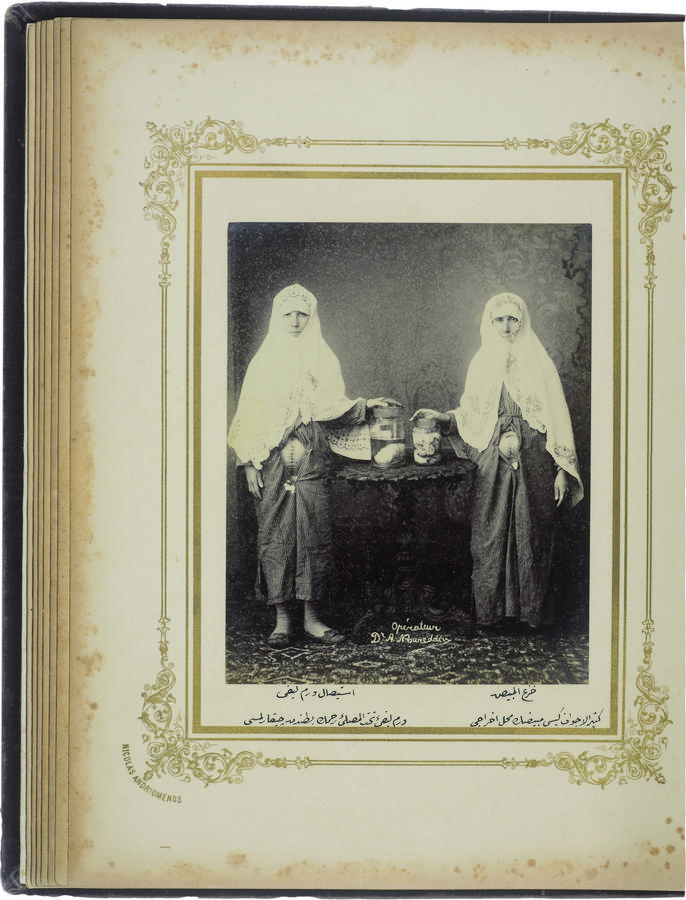
Fig. 5: Fibroid uterine tumor (left) and multicystic ovary (right) (Ömer M. Koç Album).
Müzeyyen Hatun, who had been operated on for a tumor that weighed 2.5 kilograms, was 30 years old and lived in Üsküdar. Another patient, 22-year-old Gülferer Kadın, who was from the Sultan Ahmed quarter, had a dead fetus delivered by Caesarian section; her surgery was necessitated by the fact that she had been unable to give birth naturally for eight days, and the fetus had begun to rot. Hatice Kadın, age 35, whose scar was 30 centimeters long and 17 centimeters wide, was a resident of Üsküdar; her photographic partner, 25-year-old Adviye Hanım from Kasımpaşa, had had a tumor removed from her intestine which had adhered to her uterus (see Fig. 5).
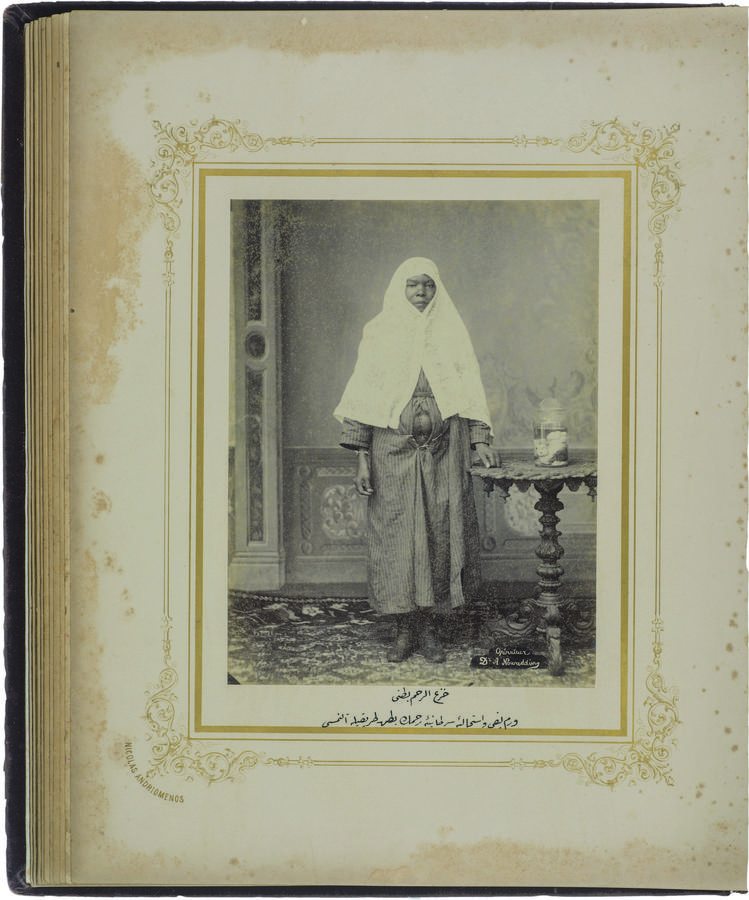
Fig. 6: Fibroid cancerous tumor (Ömer M. Koç Album).
Mişli (?) Hatun, whose wound was vertically 25 centimeters long, lived in Aksaray and was 40 years old. Only one woman was identified, not by name, but by skin color: a 45-year-old black woman from Kasımpaşa, whose surgery entailed the removal of her entire uterus, together with a tumor (see Fig. 6).
The albums with pictures of female patients treated by dedicated experts in the modern facilities of the Haseki Hospital present a unique episode in the history of Ottoman medical photography. Whereas most photographs of this type focus on parts of the body (as in the X-rays), these images show women whole, healthy, and dressed, with their hospital clothes parted to expose their postoperative scars and headscarves folded to reveal their faces. They thus break through the convention in which patients are depicted through their illnesses, or people are reduced to ethnographic types or categories of economic class. Instead, these are a striking hybrid: both objectified medical documents and assertive individuals.
Reading Ottoman modernity from photographs documenting the work carried out in different areas (as diverse as medical science, construction, mining, and archaeological excavations) broadens and refines the overall portrait of the empire, shifting the focus of the scholarly discourse on photography in the Middle East. Some of these images circulated widely (such as the photographs of the Hijaz Railroad construction), whereas others did not at all (such as the photographs of female patients). Some display a high artistic value, whereas others are simply utilitarian. Together, they offer views of the Ottoman Empire at work while consistently emphasizing the overarching theme of modernity. Inadvertently, they also celebrate the humble people of the empire, from teams of anonymous laborers on railroad construction sites and archaeological digs to named individuals, among them the soldier Osman bin Ibrahim, wounded by a bullet in his foot, and the patient Gülferer Kadın, who lost her baby but survived thanks to a Caesarian section performed by a skilled surgeon after she had unsuccessfully tried to give birth (see Fig. 7).
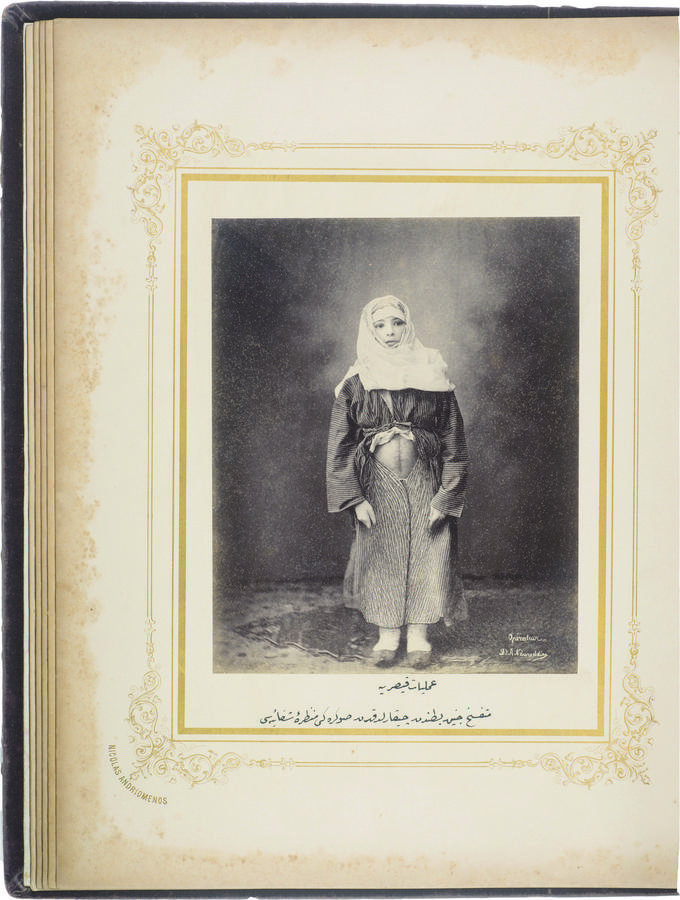
Fig. 7: Gülferer Kadın, who lost her baby but survived thanks to a Caesarian operation (Ömer M. Koç Album).
8.4 Conclusion
It is useful to ask some questions which may not be possible to answer but which trigger meaningful scenarios. What was the nature of the teamwork? How did a young Turkish doctor and a Greek photographer decide on the project and its format? How did they communicate their intentions to the patients? How did they convince them to pose for a public they did not know? What kinds of negotiations and conversations took place between the doctor and the photographer, the doctor and the photographer and the patients, the patients themselves, and the patients and their families? Were the patients given copies of their photographs? What was the range of dissemination of the album? How many copies were made? Where were they sent? To Paris? To Vienna? To the new and modern Ottoman hospitals in the provinces, at least the major ones (Bursa, Damascus, and Aleppo)? How did the captions differ for different viewers?
On the basis of open-ended questions like these (and many more), the issues raised by this collection suggest that it was most likely used for different purposes, providing opportunities for scholarly analysis from multiple disciplinary perspectives. Most strikingly, the albums attest to the use of photography for documenting the state of medical science. Provided that multiple copies were produced and distributed, they point to the transmission of scientific information visually. As an anthropological and sociological inquiry into the lives of modest women, the photographs unsettle the prototypes about gender in a “Muslim” society and, as a hybrid category in the history of photography, they transcend the established norms of representing the Middle East and, in particular, Middle Eastern women. They also provide a study that complicates the history of modernization in the Middle East—not as a tale of government initiatives but as a project that has affected ordinary people. Finally, they serve as a proud advertisement of the empire’s modernity.
8.5 List of figures
• Fig. 1: X-ray of Osman bin Ibrahim’s foot, unidentified photographer, c.1896, Istanbul University Central Library (İÜMK), sign. 779-41-0021.
• Fig. 2: Patrocle Kampanaki, site plan of the Haseki Sultan Hospital, unidentified photographer, 1890, ink and watercolor on paper, İÜMK 90833-0016.
• Fig. 3: Haseki Sultan Hospital, administrative building, Abdullah Frères, c1892, İÜMK 90833-0003.
• Fig. 4: Tumors extracted from wombs, Nicolas Andriomenos, c1895, private collection of Ömer M. Koç.
• Fig. 5: Fibroid uterine tumor (left) and multicystic ovary (right), Nicolas Andriomenos, c1895, private collection of Ömer M. Koç.
• Fig. 6: Fibroid cancerous tumor Nicolas Andriomenos, c1895, private collection of Ömer M. Koç.
• Fig. 7: Gülferer Kadın, Nicolas Andriomenos, c1895, private collection of Ömer M. Koç.
8.6 References
Çelik, Zeynep (2008). Empire, Architecture, and the City: French-Ottoman Encounters. 1830–1914. Seattle, WA, and London: University of Washington Press.
Çelik, Zeynep and Edhem Eldem, eds. (2015). Camera Ottomana: Photography and Modernity in the Ottoman Empire. 1840–1914. Istanbul: Koç University Press.
Evens, Ronald G. (1995). Röntgen Retrospective: One Hundred Years of Revolutionary Technology. Journal of the American Medical Association 274(11): 912–916.
Necipoğlu, Gülru (2005). The Age of Sinan: Architectural Culture in the Ottoman Empire. Princeton and Oxford: Princeton University Press.
Osman, Hamdy Bey and Marie de Launay (1873). Les Costumes populaires de la Turquie en 1873. Constantinople: Imprimerie du Levant Times and Shipping Gazette.
Özlen, Fatma (October 2014). Röntgen Devrimi. Tarih 20:82–89.
Öztuncay, Bahattin (2003). The Photographers of Constantinople: Pioneers, Studios, and Artists from 19th Century Istanbul. Istanbul: Yapı Kredi Yayınları.
Taşkıran, Nimet (1972). Haseki’nin Kitabı. Istanbul: Yenilik Basımevi.
Footnotes
For an analysis of this phenomenon, see Çelik and Eldem 2015. This essay is based on Zeynep Çelik’s chapter, “Photographing Mundane Modernity,” ibid.
Abdülhamid II’s albums are now housed in the Istanbul University Central Library (İÜMK). The list of photographs of hospitals is long. For example, psychiatric hospitals in Aleppo and Manisa are represented in single photographs (İÜMK 90454/55 and 90410/4, respectively), as were the military hospitals in Salonika and Damascus (İÜMK 90854/49 and 90460/3, respectively), and the municipal hospital in Jerusalem (İÜMK 90504/71). An entire album is devoted to the Hamidiye Hospital in Damascus (İÜMK 90586), whereas the number of albums and photographs of the Hamidiye Hospital in Istanbul surpasses all others.
On the proto-regionalism of the hospital building and their photographs in Servet-i Fünun, see Çelik 2008, 187–189.
“Dersaadet’de Röntgen Üsuluyla Fotograf Ahzı,” Servet-i Fünun 11, no. 277 (30 Haziran 1312 / July 2, 1896): 267.
There are many photographs of this type in the Abdülhamid II albums. See, for example, İÜMK 90506/0004 for a hernia operation, 90506/00005 for removal of a neck tumor, 90506/008 for removal of an arm tumor.
“Haseki Nisa Hastahanesi,” Servet-i Fünun, v. 2, year 4, no. 85 (15 Teşrinevvel 1308 / October 27, 1892), 111.
Necipoğlu 2005, 271–273. Today, the neighborhood is called Haseki.
This mansion, previously owned by Moralı Ali Bey, had served as the hospital proper since 1879; see Taşkıran 1972, 133. Kampanaki’s undated plate is most likely from the early 1890s.
“Haseki Nisa Hastahanesi,” Servet-i Fünun, v. 2, year 4, no. 85 (15 Teşrinevvel 1308 / October 27, 1892), 111.
“Dr. Ahmed Nureddin Bey,” Servet-i Fünun, v. 10, no. 242 (19 Teşrinevvel 1311 / October 31, 1895), 120.
İÜMK 90608.
